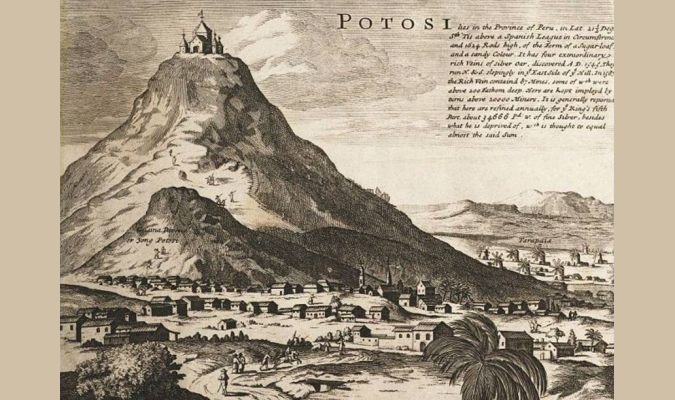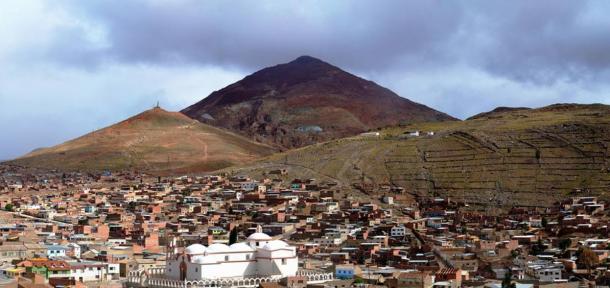Legend of the Silver Mountain of the Inca Kingdom
It was gold and silver that attracted Spanish people to the expeditions and conquests of America. In the 1530s, less than 50 years after Christopher Columbus set foot on the New World, the Spanish successfully conquered the two powers of the continent: the Aztec and Inca empires.
Discover the Silver Mountain legend of the Inca Kingdom

Cerro Rico de Potosí mountain was portrayed in 1715, possibly the origin of the Sierra de la Plata legend.(Photo: Wikimedia)
However, the encounter with these powerful empires together with the material possessions only blow up the imagination as well as the European desire for gold. Both before and after these empires collapsed, legends of legendary cities and treasures of gold and jewels appeared in the Spanish invaders, making the adventurers deeply engaged. more inside this continent.
One of the legends spread among them is the story of the Sierra de la Plata.
The Sierra de la Plata is literally " Silver Mountain" . This is a legend about a city filled with unimaginable amounts of silver. Although the Spanish eventually found silver mines in the city of Potosi in 1545, it was not the same as the legend of the Sierra de la Plata. One of the reasons is, although Potosi is located far away from present-day Bolivia, the Sierra de la Plata is said to be located somewhere deep inside the jungle of Brazil . Moreover, Potosi's "sovereignty" has not been declared until the Spaniards appeared, and the Sierra de la Plata is said to have been ruled by a " White King".

Some believe that the legend of the Sierra de la Plata originated in the mountains of Potosi.View of the city of Potosi (Cerro Rico mountain).(Photo: Wikimedia)
The legend of the Sierra de la Plata can be traced back to the early 16th century. In 1515, the Portuguese explorer Juan Díaz de Solís was instructed by the King of Spain to find the mysterious strait connecting the Great The Atlantic Ocean with the southern waters of Balboa, the Pacific Ocean.

The landing of Juan Diaz de Solis on the Eastern Band coast (Uruguay today).He was hunted and murdered by the Charrúas natives.(Photo: Wikimedia)
The survivors of the expedition decided to return to Spain, and they sailed north along the Brazilian coast. However, a violent storm sunk one of their ships off the island of Santa Catrina.
An estimated 18 survivors, one of whom is a Portuguese explorer named Aleixo Garcia . The fate is not so harsh for those who survive the shipwreck, when the sea becomes more calm. The climate is quite mild, rich forests and abundant hunting animals are a good source of food supply. Clean streams also gave them drinking water. Moreover, the indigenous people - the Guarani people proved quite friendly and treated them well.
They were stuck for many years, and Garcia finally learned the language of the natives. Through conversations with the Guarani people, Garcia learned the stories of the Incas , the Sierra de la Plata and the White King.

The map from Miller Atlas (1519) outlines the Brazilian coast and the Río de la Plata estuary.(Photo: Wikimedia)
This story prompted Garcia to lead an expedition to find this rich city. Garcia gathered an army of 2,000 Guarani warriors, who were very enthusiastic about the Inca raid scenario. Leaving behind his two men (to contact any European ship that could stop by the area), Garcia headed west, then finally reached the foot of the Andes.
In the area somewhere between Miaque and Tomina, Garcia and his Guarani army had infiltrated the Inca border, and began plundering and rape when they attacked. In the towns of Presto and Tarabuco, near Sucre, the Bolivian capital today, the Incas finally stopped the invaders. Faced with the resistance of 20,000 trained Inca warriors, Garcia decided to withdraw in a tactic to strengthen reinforcements and protect the spoils.
However, before returning to Santa Catarina Island, Garcia, the Europeans who accompanied him and a large number of Guarani people were murdered on the Paraguay River , far from the Inca territory. A later record recorded that Garcia was murdered in the spring of 1525, although it is unclear whether the attackers he was aboriginal allies or a completely different indigenous people.
Soon afterwards, a ship named San Gabriel arrived in Santa Catarina, where the crew found Ramirez and Montes, the two whom Garcia left behind. These two instructed the captain of some Inca silver that Garcia sent them. However, the relationship between them and the captain became worse, the ship San Gabriel went out to sea not long afterwards without them.
However, the story of the Sierra de la Plata began to spread and eventually reached Europe. Although the Spaniards successfully captured the ruler of the Inca Kingdom, Atahualpa in 1532, the stories of the Sierra de la Plata continued to inspire Europeans, and the explorers continued. keep looking for this legendary mountain as well as its White King .
Even though the search did not bring results, this legend still lives on the Rio de la Plata river and in Argentina, both places have names derived from the myth of the Sierra de mountain. la Plata.
- Mountain bear legend
- Ancient Inca city on high mountain 4,000m
- Fraternity is similar to the collapse of the Inca empire
- The reason should wear silver jewelry
- The United Kingdom found the latest high mountain - Hope Mountain
- Find the 'secret' of silver metal
- Mummy of an Inca girl wearing poisoned clothes in Chile
- Excavating the forgotten kingdom in Scotland
- Sweden returned the pre-Inca shroud to Peru
- The treasures in the legend are not yet found
- The girl's remains revealed the terrifying power of the Inca empire
- Is Noah the true ship?
 'Fine laughs' - Scary and painful torture in ancient times
'Fine laughs' - Scary and painful torture in ancient times The sequence of numbers 142857 of the Egyptian pyramids is known as the strangest number in the world - Why?
The sequence of numbers 142857 of the Egyptian pyramids is known as the strangest number in the world - Why? History of the iron
History of the iron What is alum?
What is alum?